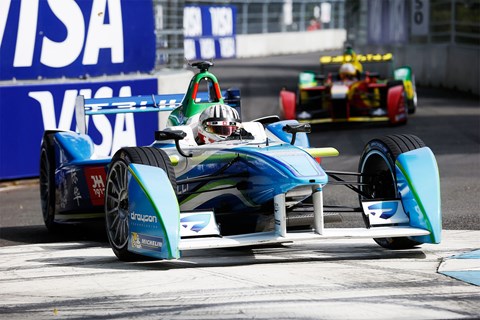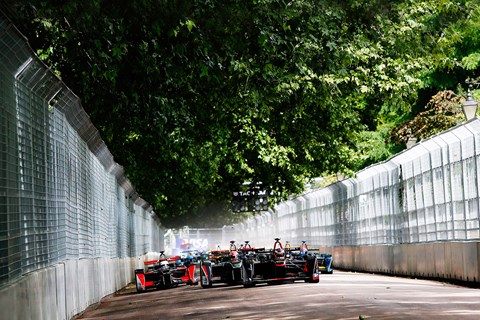► Formula E’s second season blasts off this weekend
► We were there at the conclusion of its opening season
► How well does the championship work as a spectacle?
Formula E, the FIA’s brave new all-electric racing series, begins its second season this weekend in Beijing. In an article from CAR magazine’s August 2015 issue, we revisit the final round of its opening season at London’s Battersea Park to reflect on how well the silent, street-bound championship works as a spectacle.
Has there ever been a start-up racing series that’s garnered more column inches than Formula E? The all-electric, city-based single-seater championship seemingly has as many virulent detractors as it does passionate evangelists, but the point is: everyone’s talking about it. And with London’s Battersea Park the venue for the season finale, we had to drop in, to satisfy our curiosity.
Morning practice is underway as we arrive. From trackside, the cars’ much debated sound (or lack of) isn’t exactly goosebump material but it is more nuanced than the Scalextric white noise you hear on TV; a blend of transmission whine and gearchanges (all cars have a sequential gearbox), swooshing road noise and occasional tyre squeal from the treaded Michelins. And when the latter let go, you can hear the resultant ‘ooooh’ from the crowd whenever someone makes a big save. As the cars pelt past at full tilt you can easily maintain relaxed conversation, and hear the commentary over its bed of incongruous dance music pumped out by the Formula E ‘EJ’ – one of the more forced elements of the festival atmosphere.

It’s not just the sound and fury of racing engines that’s conspicuous by its absence. There’s not much in the way of crowding either. Around 60,000 people come through the gates from Friday to Sunday; the four-day Goodwood Festival of Speed on the same weekend had 200,000. As Saturday’s action rages quietly on, one woman sits reading a paperback on an empty grass bank an underarm stone’s throw from the start-finish line. Elsewhere, buoyed by afternoon sunshine, people languish on benches and stroll around the park. Many of them are families with children, enjoying a day out. Few pay much attention to the racing.
You can’t blame them. The 1.8-mile track around the park’s perimeter roads is so narrow (around 9m at its widest) overtaking is all but impossible and with a dearth of big screens, the view at each grandstand is limited to a brief snapshot of the cars as they whir through the track’s chicken-run confines – usually in the same order as the lap before. There’s no doubting the calibre of the drivers (the grid’s packed with ex-F1 and Le Mans stars), or the skill they display around the bumpy, unforgiving layout but ultimately a tight circuit with barely any passing opportunities is unlikely to enamour the casual racing fans the sport aims to attract.

There’s some genuine intrigue in the decider on Sunday, however, as eventual champion Nelson Piquet Jr is forced to scrap for points from 16th on the grid after encountering the only rain of the weekend during his qualifying run, and Brit Sam Bird scores a welcome, but confusing, home win by dint of on-the-road victor Stéphane Sarrazin using up more of his car’s allotted energy than permitted. A fittingly unpredictable end to a divisive first season.
Viewing Formula E as a competitor to F1 is as foolish as it would be to dismiss it out of hand; it’s in its infancy after all, and will continue to learn and evolve. Insiders tacitly admit making it to the end of the first season was a challenge in itself. That it offers something different is undeniable; given time, it will offer more exciting racing too. Maybe it was the weather, but folk looked happy heading home from Battersea. Perhaps we should give peace (and quiet) a chance.